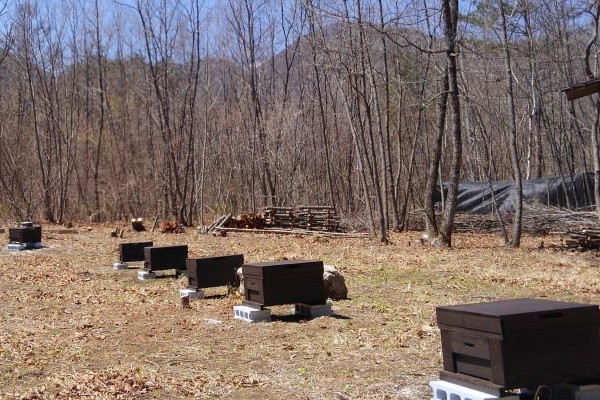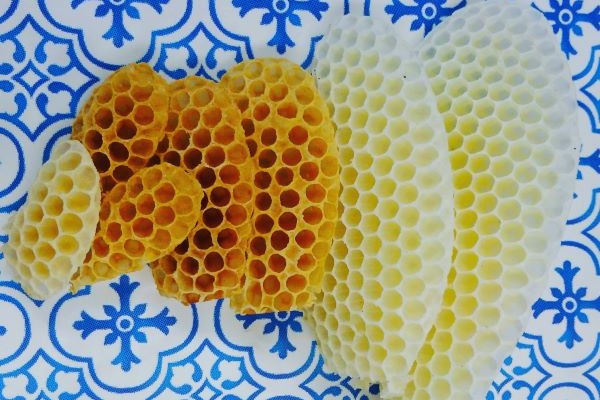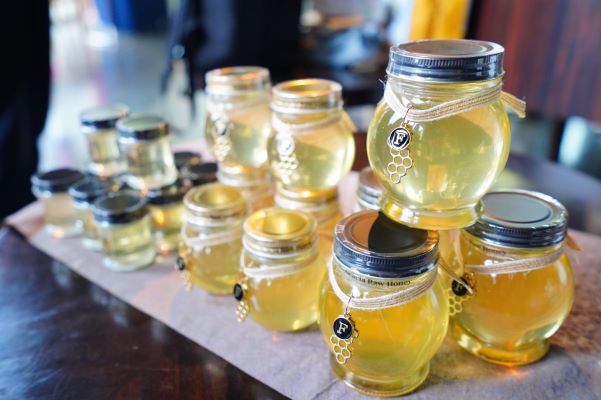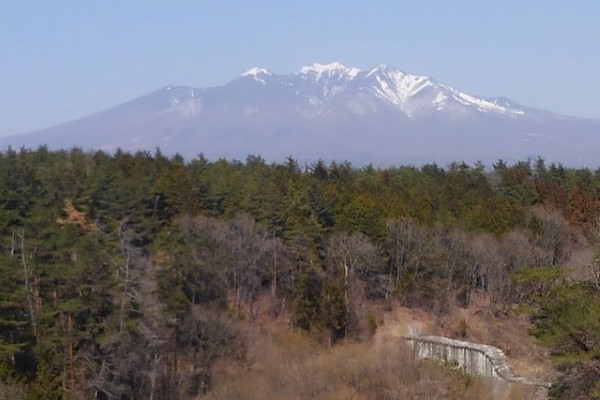Water is the source of deliciousness. Yamanashi, land of famous water
Yamanashi Prefecture is known for spring water, which you can find all over the district, and the prefecture is also called “natural water bottle. Seven locations have been selected as one of “the 100 best waters” and “the 100 best waters of the Heisei period” in Japan. The famous spring water comes from mountains such as Mt. Fuji, Yatsugatake, Southern Japanese Alps, and Okuchichibu. The rain and melted snow that falls on the mountains, seeps into the earth. Taking a long time, said to be 20 years or more, as it is filtered underground, becomes clean water rich in minerals dissolved from strata and rocks. Water is one of the most important resources in all industries, starting with fruits, agricultural products such as rice and vegetables, marine products such as fish, livestock products such as beef, pork and chicken, and alcohol. The spring water is one of the reasons why Yamanashi Prefecture's fruits are so delicious. Other reasons are the long hours of sunshine and the stable soil and climate. We would like to tell you more about this story some other time. Please try the delicious Yamanashi spring water. In Yamanashi Prefecture, known as the “fruit kingdom”, naturally, fruits are a popular gift. There are various fruits such as peaches, Shine Muscat, grapes and persimmons. Wine, local beer, and Japanese sake are also very popular. They are special products unique to Yamanashi Prefecture, which is blessed with delicious water. Another must-have is Shingen-mochi. It is so popular that it is called Yamanashi's soul food. The sticky rice (or glutinous rice), Kinako (roasted soybean flour), and brown sugar syrup gives it a simple yet smooth texture that makes you want to eat more and more. If you happen to see them, be sure to try!
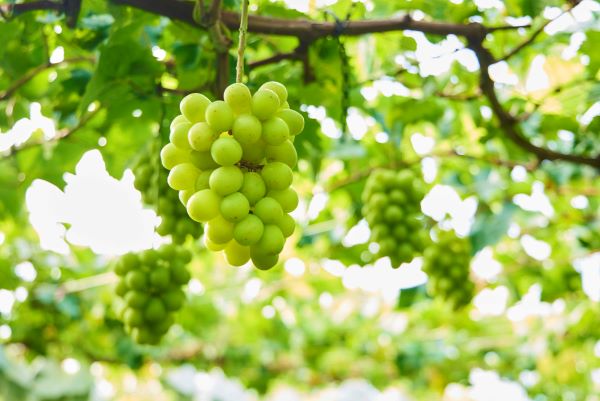
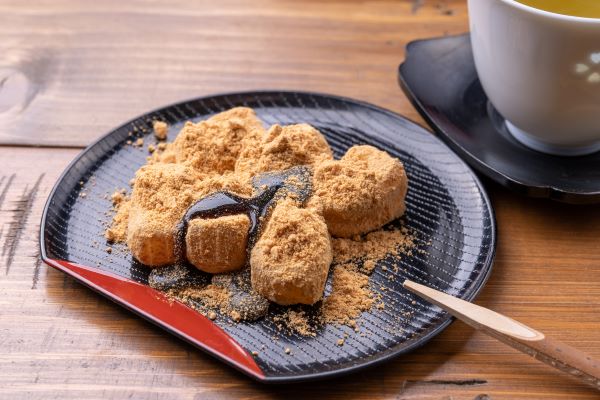
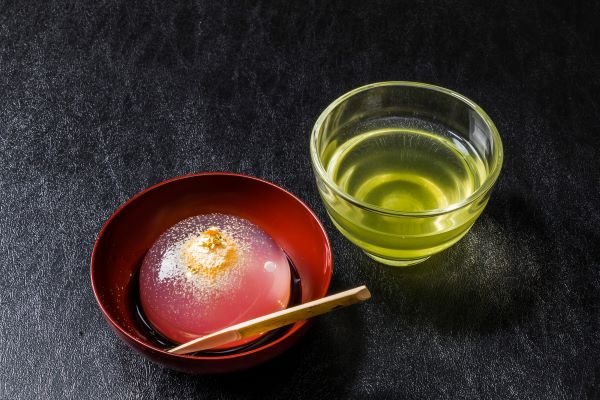
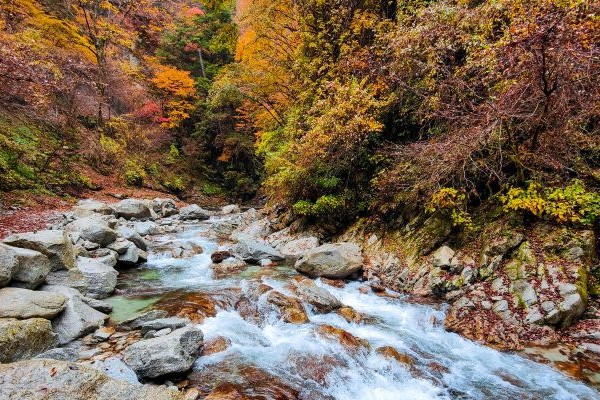
"Oshino Hakkai", one of Japan's leading clear water and famous spring water villages
Lake Yamanaka is one of the popular tourist destinations in Yamanashi Prefecture. Oshino Village, located close to Lake Yamanaka in Yamanakako Village, is known as one of Japan's leading clear water and famous spring water villages, including the popular spot "Oshino Hakkai", which was selected as one of the "100 Best Waters in Japan". Today, we will introduce such "Oshino Hakkai", or the Eight Seas of Oshino. Oshino Hakkai, a popular tourist attraction, is the general name for eight ponds that draw on Mt. Fuji's underground water. All eight ponds are certified as constituent assets of Mt. Fuji, a World Cultural Heritage site. Constituent assets are cultural assets that can concretely prove the value of Mt. Fuji as an object of worship and a source of artistic inspiration. There are a total of 25 constituent assets of Mt. Fuji and all of them together are designated as a World Cultural Heritage Site. "Oshino Hakkai" has a history of being a training ground for Mt. Fuji worship during the Edo period (1603-1867). It is a sacred place with a legend and is also known as a mysterious power spot. Each pond has a name based on a folktale that has been passed down since ancient times. Among them, the fifth sacred place "Wakuike" is the representative of "Oshino Hakkai". The amount of spring water is the largest, and it is characterized by beautiful, clear blue water. The water is so beautiful that in 1983, NASA used the spring water in an experiment to make snow in space. You can enjoy the beautiful scenery that spreads nostalgia, which can be said to be the original landscape of Japan. We hope that you will visit the solemn and mysterious spring pond.
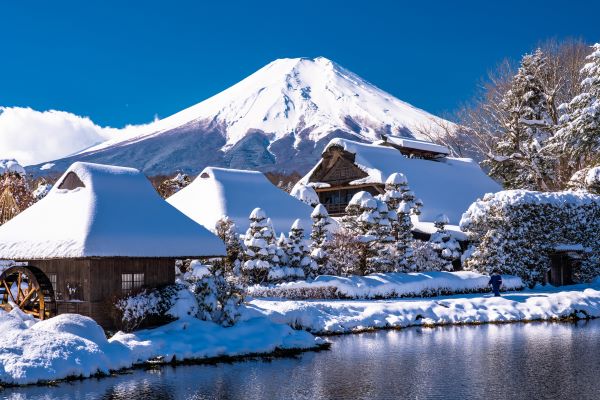
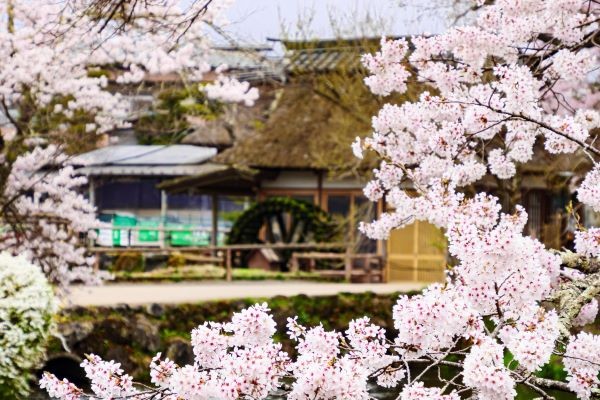
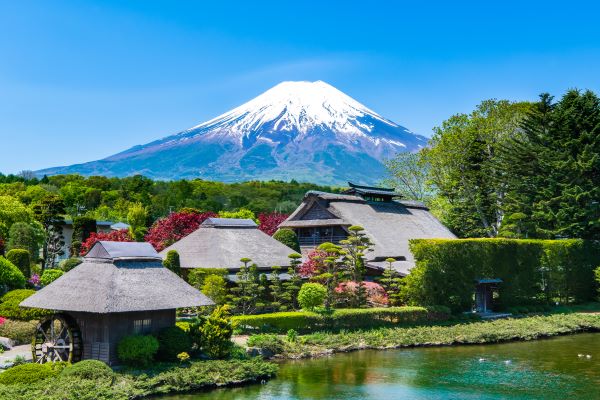
The charm of “Hottarakashi Onsen” that warms your body and soul!
Hot springs, or Onsens, are one of the things that has been widely popular in Japan since ancient times. Boosted by the recent health boom, it is widely recognized essential for maintaining and improving health. In Japan, there is a law called “Hot Spring Law”, and there is a solid definition. A bath filled with hot water and a hot spring are completely different things. “Hottarakashi Onsen” (“Hottarakashi” meaning neglected or left as it is) is a hot spring located about 10 minutes by car from “Yamanashishi Station” on the JR Chuo Main Line. Initially, it was planned to be used as a hot spring for a nursing home, but as soon as the hot spring began to flow after mining to a depth of 1,500m, the construction of the nursing home was cancelled. Therefore, they handmade the hot spring bath “Kocchi no Yu” and opened it to the customers, which is the beginning of “Hottarakashi Onsen”. This unique name comes from this idea: "Other hot spring resorts offer a variety of services, but there are none here. To avoid disappointing our customers, let's declare in advance that we are neglecting them!" Hottarakashi Onsen has two hot spring baths, “Acchi no Yu” and “Kocchi no Yu” (meaning “this bath” and “that bath”). Both are strong alkaline simple hot springs with a mild and smooth texture. Originally, it started with the idea that "there is nothing here, but there is a hot spring and a wonderful view". However, based on the desire of the facility operator to "want customers to relax," today, rest areas, restaurants, and shops have also been built, making it a place where you can relax after taking a bath. You can bathe while admiring Mt.Fuji on a clear day, the spectacular view of the sunrise in the morning, and the starry sky at night. Being able to enjoy the scenery at any time is a great privilege. Please visit “Hottarakashi Onsen”, filled with the thoughts of the facility operator.
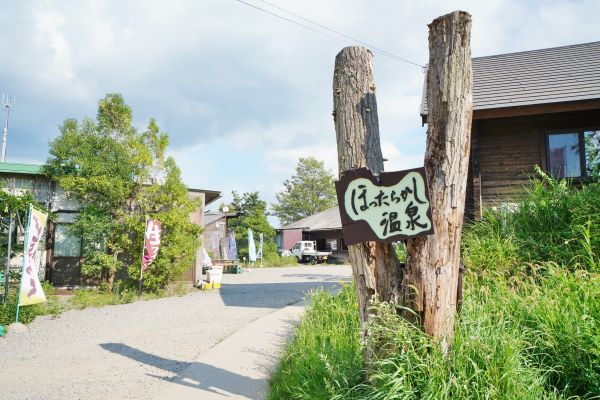
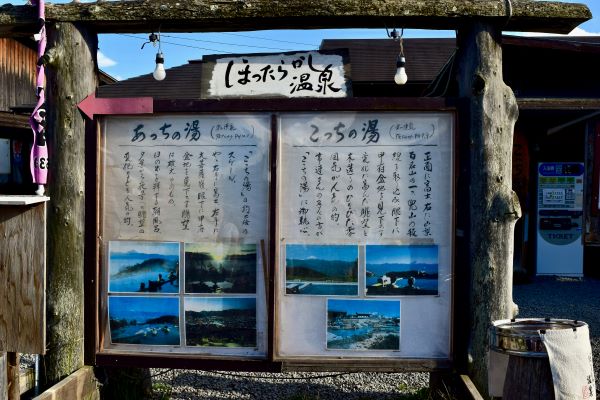
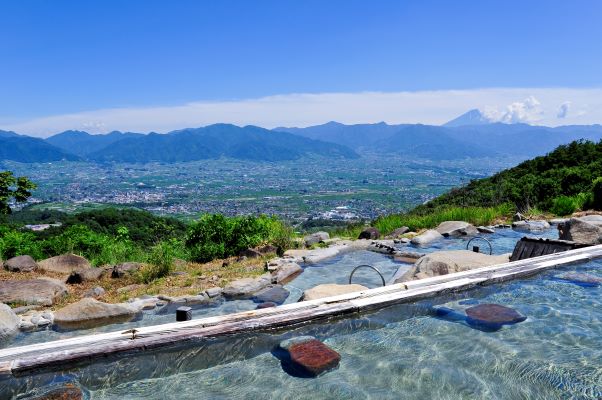
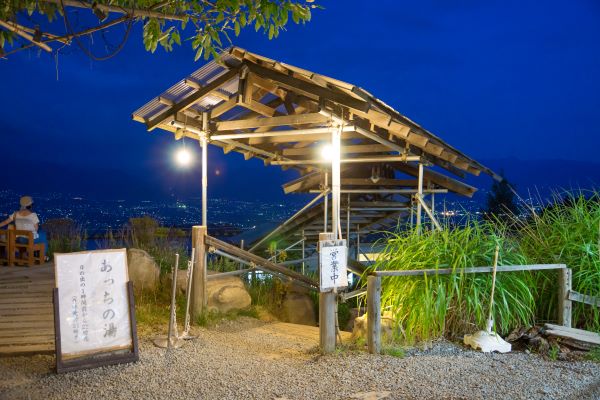
Are special geographical landforms effective?! Discover the charm of Yamanashi fruit from the terrain
・Alluvial fan
Do you know the terrain called alluvial fan?
An alluvial fan is a geological landform in which sediment is deposited in a fan-like shape when it is carried by a torrent river flowing through a narrow mountainous area and reaches a wide flat land, where the flow weakens.
The alluvial fan is a terrain formed by the accumulation of gravel (small round stones). Therefore, it is characterized by good drainage. When it comes to good drainage, what comes to mind is the growing conditions for fruit.
Water is essential for fruit cultivation, but if water is given more than necessary, the tree could die from root rot or get sick. There are also varieties where the less water you give, the more the sweetness of the fruit is concentrated.
In addition, due to the characteristics of the alluvial fan, the elevation decreases from the top of the fan to the edge of the fan. This slope is very important to ensure the amount of sunlight, because sunlight is essential for fruit cultivation.
In the Kofu Basin in Yamanashi Prefecture, there are many alluvial fans. Since the alluvial fan is often used for grape cultivation, it can be said that the Kofu Basin has become a major production area for grapes.
Of course, just because the soil is good doesn't mean it will produce good fruit. It is the result of the agricultural policy of Yamanashi Prefecture and the efforts of the people.
In addition, in July 2022, fruit cultivation using the alluvial fan that spreads out in the “Kyoto region” (Yamanashi city, Fuefuki city, and Kofu city) of Yamanashi Prefecture was certified as a Globally Important Agricultural Heritage System.
This is one of the episodes in which traditional agriculture and its scenery were recognized by the world.
Yamanashi Prefecture has many tourist orchards where you can eat the fruits you pick yourself.
Please visit and enjoy the scenery.
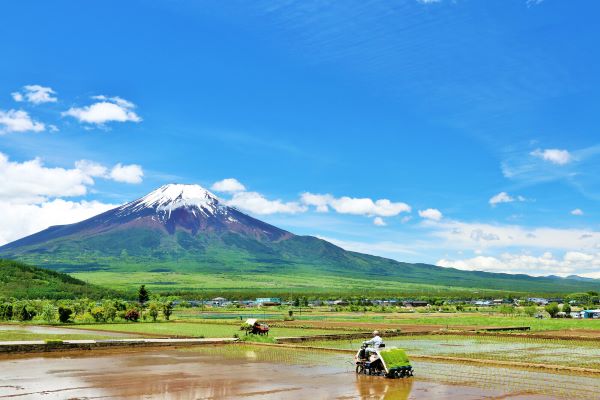
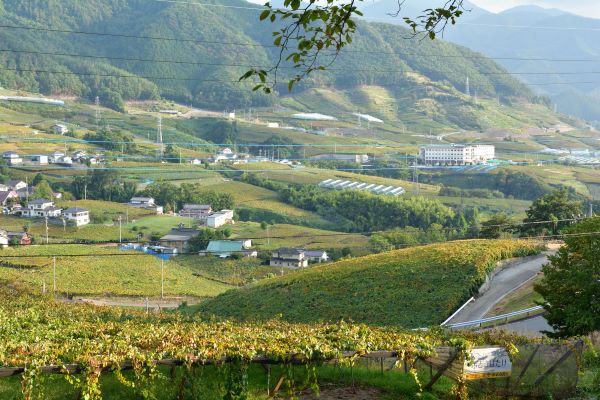
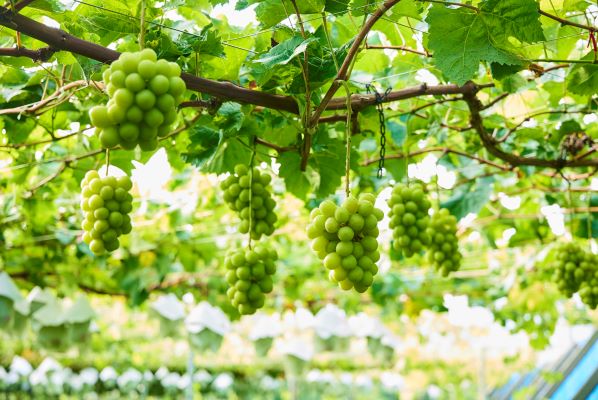
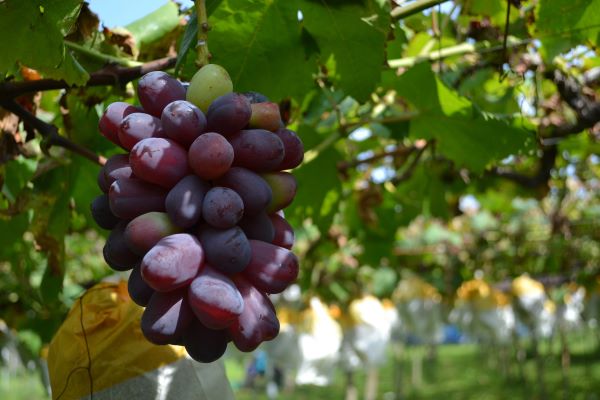
Farmer's secret of deliciousness (Shine Muscat)
We asked Mr. Hirokazu Ogino, a grape farmer in Yamanashi Prefecture, about the charm of Shine Muscat, which is in season now. Mr. Ogino is the fourth-generation farmer of a family that has been a farmer in Minami-Alps City, Yamanashi Prefecture for many years. 10 years ago, he began to specialize only in cultivating grapes, and started full-scale production. In the 2020 Yamanashi Prefecture Fruit tree Exhibition, he won grand prize in the Grape "Shine Muscat" (long pruning, open field cultivation) category. Mr. Ogino says that soil preparation is important for growing good grapes. He seems to place importance on creating an environment in which healthy roots can grow. Based on data rather than intuition, he changes the amount and quality of fertilizer and scatters rice straw into the soil. He is very particular about the soil. Mr. Ogino says that “long pruning” is essential to create the best environment for vines. Judging and pruning the necessary branches from among the branches that have grown that year may seem easy, but it requires a lot of skill and experience. This pruning work is very important to produce uniformly sized and high quality grapes. Based on the know-how that has been passed down from generation to generation, Mr. Ogino is trying to create a new style of grape cultivation by introducing an IoT system. He says that he wants to pass down the know-how of grape cultivation to future generations, and not just make grapes suitable for the modern environment where global warming is progressing. Such attitude of each producer, looking ahead to the future, is probably one of the reasons why Yamanashi grapes are said to be the best in Japan. Full text from here: https://www.pref.yamanashi.jp.e.aao.hp.transer.com/oishii-mirai/contents/oginoshi.html
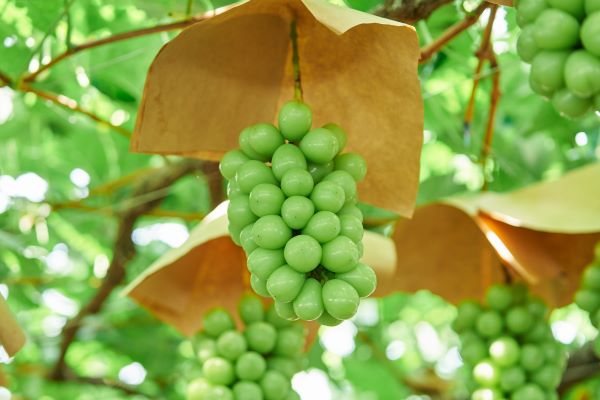
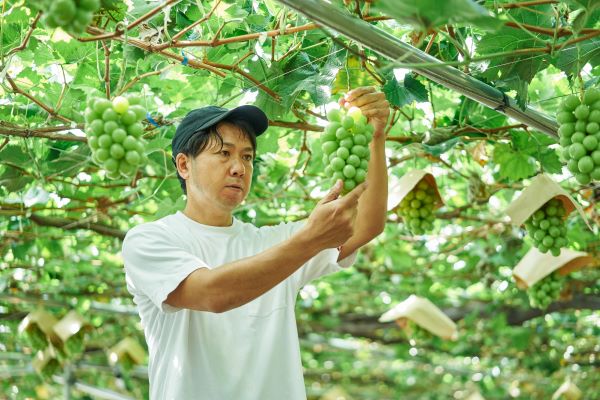
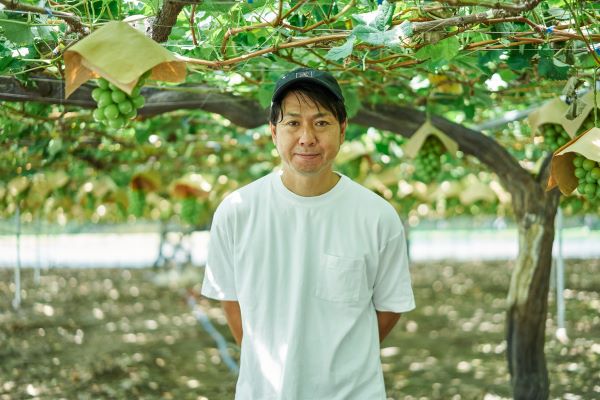
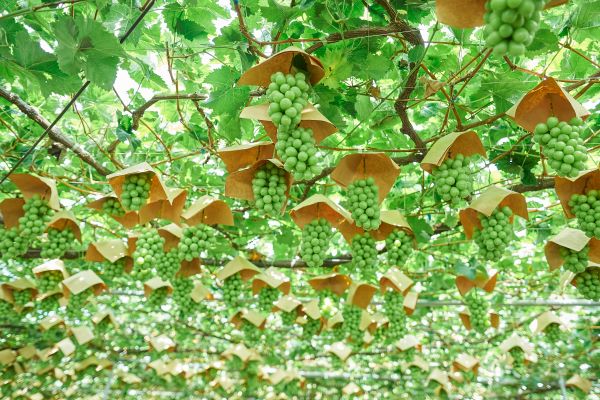
So nutritious, keeps the doctor away! Approaching the deliciousness of persimmons!
Persimmons are famous as a taste of autumn. It is a very popular fruit in Japan at this time of year. Persimmons cultivated in the climate and soil of Yamanashi Prefecture are highly evaluated as "delicious persimmons", and "Matsumoto Wasefuyu persimmons" and "Fuyu persimmons" are famous for their distinctive aroma and mellow sweetness. Persimmons are rich in nutrients: Potassium, which helps prevent high blood pressure, tannin, which strengthens blood vessels, and carotene and vitamin C, which help prevent colds. It‘s so nutritious, it keeps the doctor away! In addition, persimmon leaves are used for tea, persimmon tannin is used as an undercoat of traditional Japanese lacquer due to its antiseptic properties, and in dyeing cloth for traditional Japanese fans. It can be said that it is a fruit that has no place to throw away. Of course, fresh persimmons are also very delicious, but when it comes to persimmons in Yamanashi Prefecture, dried persimmons called “Korogaki” are famous as a specialty product. Korogaki is a candy-colored dried persimmon made from large varieties of persimmons that are often produced in Koshu City and Minami Alps City. Even among the same dried persimmons, those with a moisture content of around 50% are called "Anpogaki", and those with a moisture content of around 25% to 30%, where the sweet ingredients crystallize and white powder comes out, are called "Korogaki," and are dried for a longer period of time. It is said that the origin of the name Korogaki is that when the persimmons were dried in the sun, the peeled persimmons were lined up and kept changing (“koro-koro kawaru” in Japanese) their position so that the sun hits the entire fruit. The Matsuzato area of Koshu City has long been known as a specialty production area for dry persimmons. In winter, persimmons that are dried in fields or in front of the eaves of houses make beautiful persimmon curtains. Among the 176 local food items that Yamanashi Prefecture is working to pass on to the next generation, the dried persimmons have been selected as one of the 47 most representative items, "Specially Selected Yamanashi Foods." It can be said that the fruit is loved by many people.
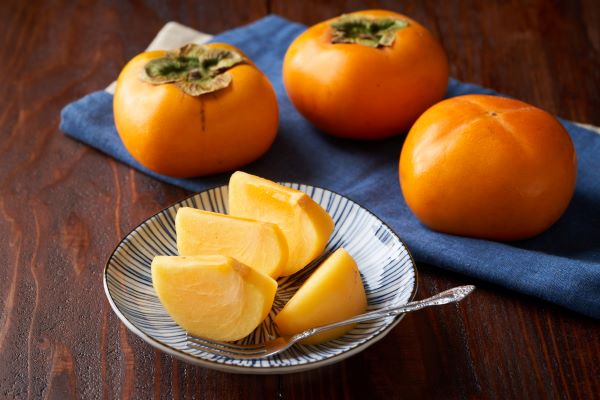
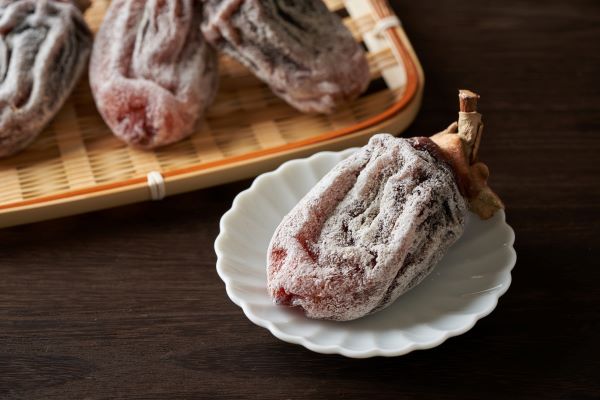
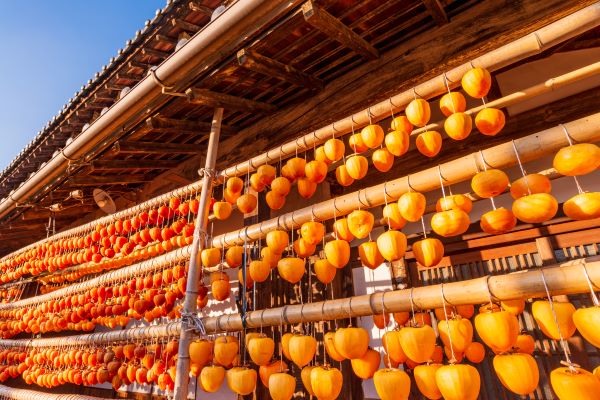
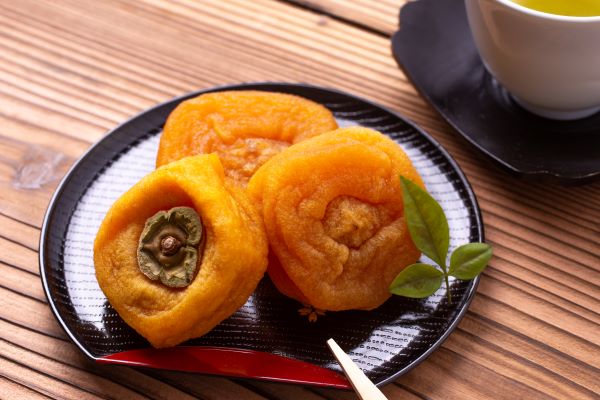
Fruit kingdom Yamanashi, working on global warming countermeasures
With the progress of science since the 1970s, understanding of the structure of the earth's atmosphere has progressed, and global warming has come to the attention of scientists as a serious problem.
Triggered by the first world conference on global warming (the Villach Conference) held in Villach, Austria in 1985, the problem of global warming caused by carbon dioxide began to be highlighted.
Global warming is progressing year by year and is still defined as one of the serious problems.
At COP21 (The 21st Session of the Conference of the Parties to the United Nations Framework Convention on Climate Change) in 2015, the French government took the lead in advocating the "4 Per Mil" Initiative.
It is a large-scale project in which, currently, 737 countries including Japan and international organizations are participating.
In April 2020, Yamanashi Prefecture became the first local government in Japan to participate.
The 4 Per Mill Initiative refers to efforts aimed at realizing a decarbonized society from the agricultural sector. "Per mil (‰)" is a unit of 1/10 of "percent (%)", and 4 per mil is equivalent to 4/1000, or 0.4%.
The idea of the 4 Per Mill Initiative is that if the amount of carbon in the surface soil of the world can be increased by 4 per mill per year, the increase in carbon dioxide in the atmosphere due to human economic activities can be reduced to virtually zero.
In detail, the amount of carbon emitted into the atmosphere by human economic activities is increasing by about 10 billion tons per year.
Subtracting the amount absorbed by trees etc. from this figure, it is calculated that emissions are increasing by about 4.3 billion tons every year.
On the other hand, it is said that there are 1.5 trillion to 2 trillion tons of carbon in the soil, of which about 900 billion tons are in the surface layer of 30 to 40 centimeters.
So, if we could increase the 900 billion tons of carbon in the surface layer of the soil by 0.4% annually, we could offset most of the 4.3 billion tons of emissions.
In Yamanashi Prefecture, as Japan's first 4 per mill initiative, a method of storing carbon in the soil by making charcoal from pruned branches of orchards of peaches, grapes, and persimmons,
which are the prefecture's main agricultural products, and sowing them in the fields, growing grass, and application of compost and pruned branch chips are applied.
Efforts are also being made to brand the agricultural products produced in these initiatives, and expectations are rising for future efforts.
Yamanashi's fruits are closely related to the 4 Per Mill Initiative, but if you're talking about seasonal fruits, it's sweet persimmons, which started shipping in mid-October.
Although it is not a large production area in Japan, it has a long history and produces high-quality persimmons.
Isawa Town in Fuefuki City, Iccho-Tanaka and Hikawa in Yamanashi City, are typical production areas. Among them, Iccho-Tanaka in Yamanashi City and Hirose in Isawa Town are famous.
In particular, persimmons from Hirose in Isawa Town have a history of being presented to the imperial family, making them a luxury brand of sweet persimmons.
[ To a delicious future > About 4 Permil Initiatives]
https://www.pref.yamanashi.jp.e.aao.hp.transer.com/oishii-mirai/contents/sustainable/4permille.html
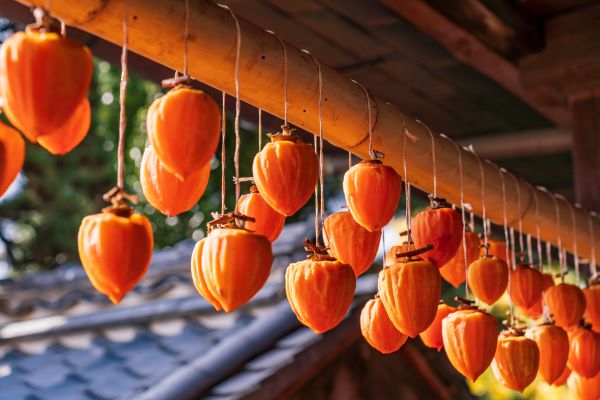
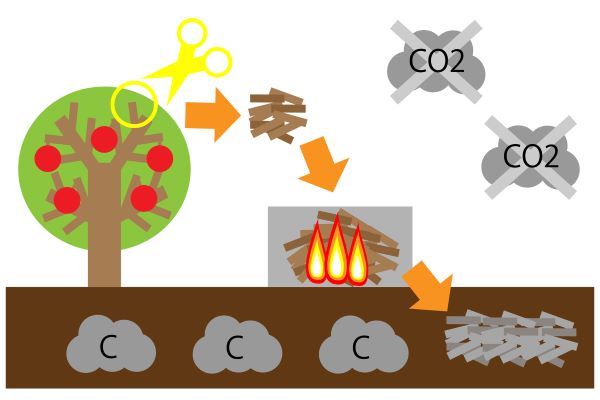
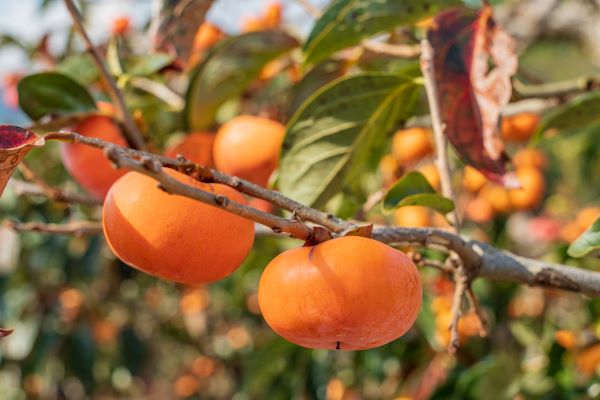
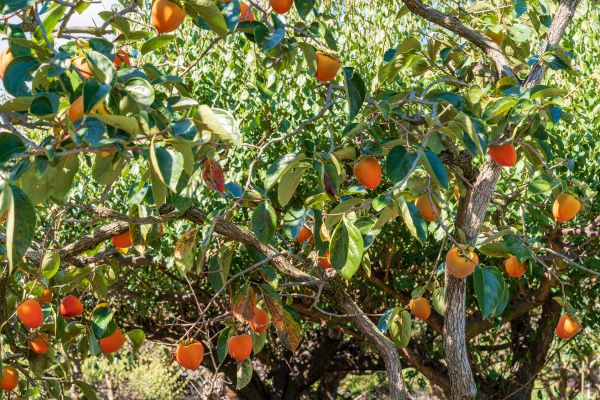
The most beautiful valley in Japan! The charm of Shosenkyo Gorge!
Mitake Shosenkyo Gorge is a valley located in the northern part of Kofu City, Yamanashi Prefecture. Designated as a special scenic spot of the country, it is said to be "the most beautiful valley in Japan" and is also a tourist attraction. You can see a unique landscape created by granite cliffs, strangely shaped rocks, and oddly shaped rocks carved out over a long period of time, as well as clear and abundant streams of water. Along the promenade at the valley, you can enjoy the beauty of the valley up close, which changes with the seasons. It is loved by many people as a popular tourist attraction in Yamanashi along with Mt. Fuji and you can enjoy a relaxing trip alone or with a large group of family and friends. Because of its convenient transportation and having many routes from the nearest station which allow quick access, it is always introduced as a famous tourist attraction in Yamanashi Prefecture. Shosenkyo Gorge has been certified as a Japan Heritage site and is an important national cultural property. It consists of 23 cultural assets, among which "Kakuenbo Peak" and "Senga Waterfall" are popular highlights. Shosenkyo Gorge changes its appearance depending on the time of the year. In spring, Mitsuba azaleas bloom and the fresh green of the dazzling promenade; in summer, the greenery deepens and the clear, cold streams and birds chirping; in autumn, the valley is dyed in fiery crimson with autumn leaves; in winter, the snow-covered waterfall is sparkling white and looks as if you've entered the world of ink painting. You can feel the four seasons of Japan with your whole body. Various activities are held depending on the season, such as canoeing, trekking, outdoor sauna, and mountain biking. As for meals, there are delicious dishes such as “hoto” which is a hot pot local dish with Udon noodles and vegetables in miso soup, a type of trout called char, soba noodles and somen noodles that are tightened in the cold clear stream. This was an introduction to the charming Shosenkyo Gorge, where you can find new discoveries and more attractions each time you visit. You can enjoy it no matter how many times you visit!
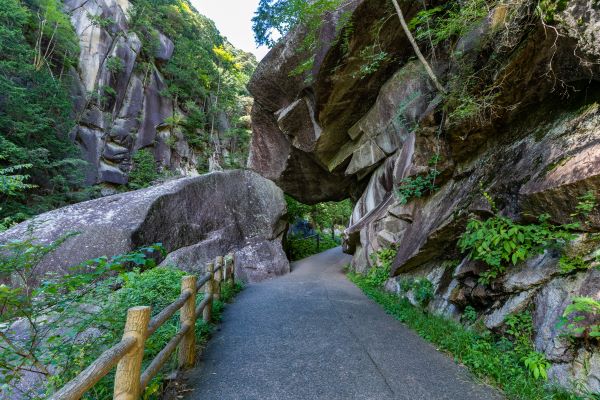
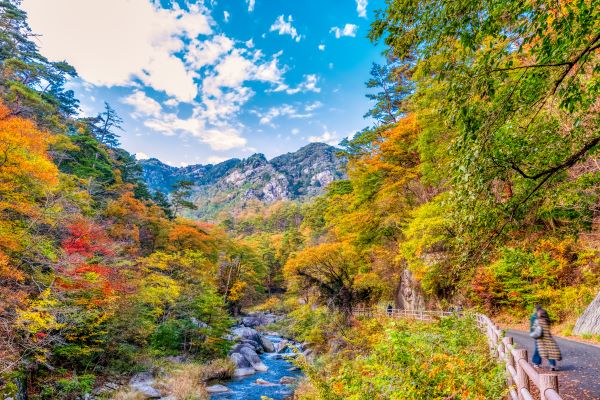
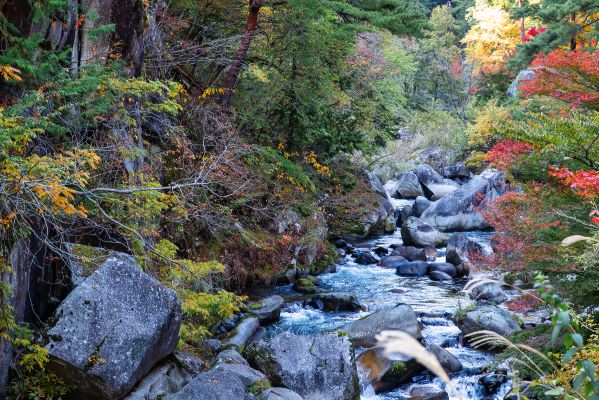
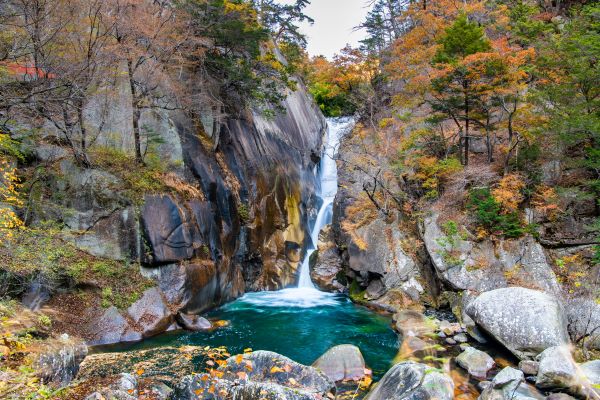
Enjoy longer! Introduction of Kogarashi grapes
It is the season for harvesting Kogarashi grapes (Kogarashi, meaning cold wintry wind in the autumn), which are shipped two months later than normal outdoor cultivated grapes. Kogarashi grapes are grapes that are grown in agricultural greenhouses to avoid rain, and are shipped about two months later than normal outdoor cultivation. It was named Kogarashi grapes because it is shipped during the current season when Kogarashi No. 1(the first wintry wind of the year) blows, and was registered as a trademark in 2017. Popular varieties such as Kyoho and Shine Muscat are mainly harvested. Kyoho grapes and Shine Muscat grapes are usually shipped from August to mid-October at their peak, and the harvest ends at the end of October. However, Kogarashi grapes are very rare because they are harvested and shipped in November. Although the price is a little higher than usual, it is popular because the grapes can be enjoyed for a longer time than the normal season without any inferiority in color, luster and taste. The fact that you can enjoy grapes for a longer period than usual is the result of the efforts of the producers. Yamanashi Prefecture is implementing many measures to support producers. Today, we would like to introduce one of them, "Yamanashi GAP". "Yamanashi GAP" is a combination of; organic farming that does not rely on pesticides and chemical fertilizers, "GAP" that thoroughly manages the production process from production to shipment of agricultural products, and Yamanashi Prefecture's unique production process management. Producers make the most of the power of nature in their production while devising ways to manage pests and weeds. Efforts to use low pesticides and low chemical fertilizers are Yamanashi Prefecture's future-oriented measures that will lead to the protection of a safe and secure future. "Yamanashi to a delicious future" A safe and secure future ~To deliver safe and secure to consumers~ https://www.youtube.com/watch?v=bqBDms0yYVs
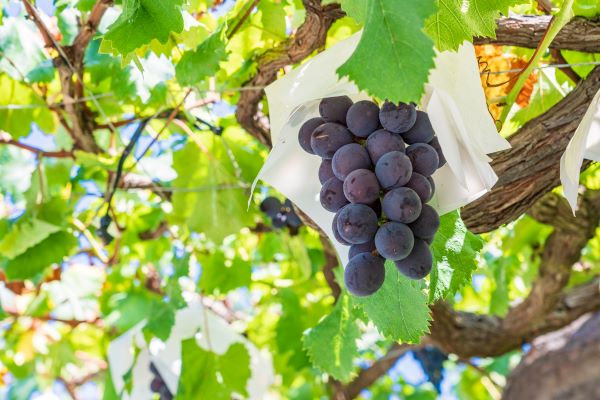
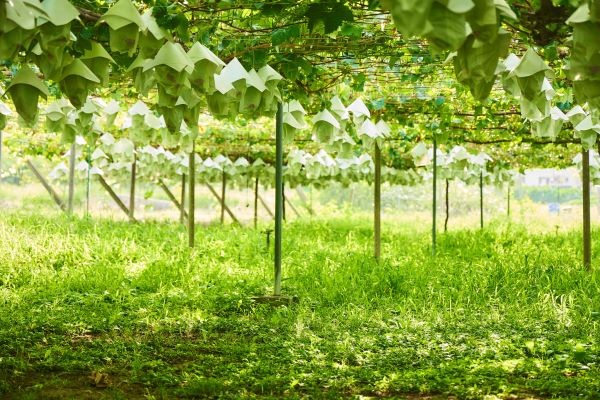
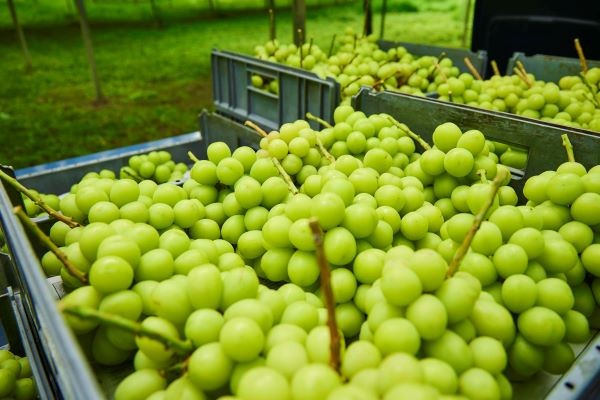
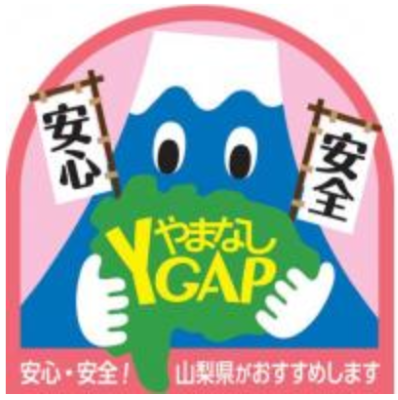
The wine is also delicious! The charm of Koshu grapes produced in Yamanashi Prefecture
"Koshu" is a grape variety with a very long history. It was discovered over 800 years ago in Yamanashi Prefecture. It has a good flavor and is suitable for making jelly and juice, and it has been used for winemaking since the Meiji period (1868-1912). Even today, wine made from Koshu grapes is considered a specialty of Yamanashi Prefecture. In 2010, it was the first Japanese variety to be registered with the International Grape and Wine Organization. When shipping wine to EU countries, it is now possible to put the cultivar “Koshu” on the label. In the Edo period (1603-1867), grapes were grown on bamboo trellis, later called the “Koshu style cultivation”. Since grapes are originally a fruit that prefers a dry environment, trellis cultivation is well-ventilated and suitable for growing grapes and became the prototype of grape cultivation in Japan. This is the origin of "Koshu style grape trellis cultivation". In the mid-Meiji period, in place of bamboo, strong wire that can be freely processed was introduced and made it possible to create trellis in any terrain. Clusters of grapes that spread like a roof, changing color between the leaves, this chandelier-like spectacle now extends to the slopes. In the Showa period (1926-1989), tunnel construction improved the distribution environment and grape cultivation became even more popular. Due to the rapid increase in tourists from the Tokyo area to Yamanashi Prefecture, tourist vineyards have increased along major roads. Nowadays, during the harvest season, the area is bustling with tourists enjoying grape picking. Please visit Yamanashi's vineyards.
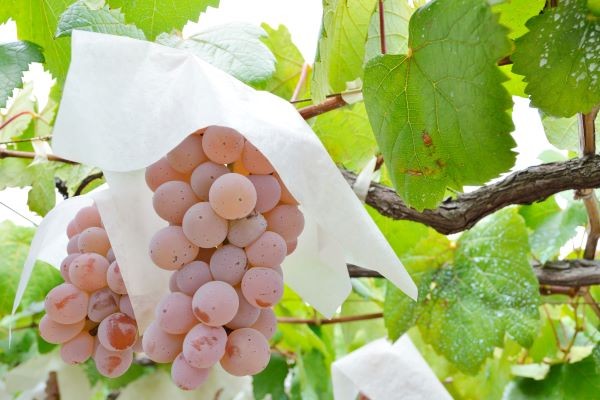
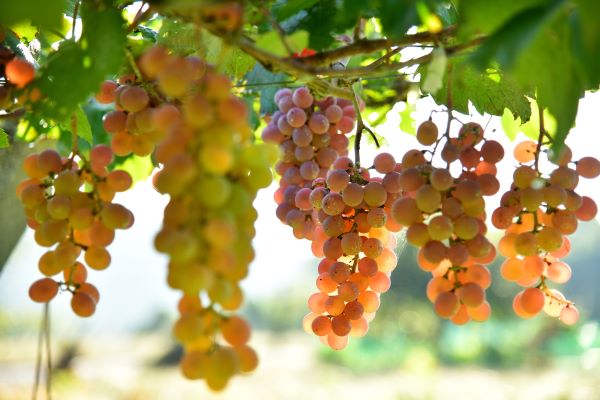
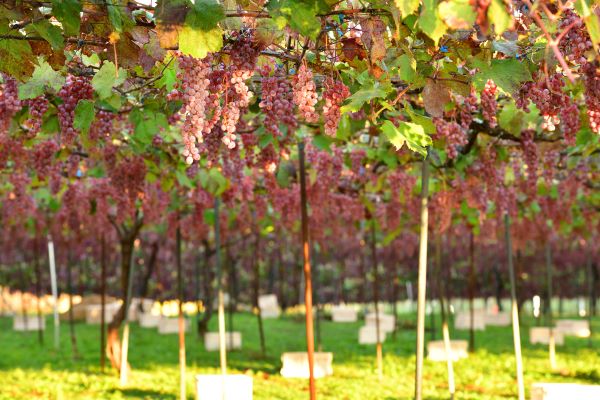
Fruit Kingdom Yamanashi
“Kaiji” is a grape that was born at the Grape Research Institute in Yamanashi Prefecture and was registered in 1977. It is also called "Red Muscat". As the alias "red muscat" indicates, it has a gorgeous muscat scent and has a very high sugar content. It is difficult to peel off the skin, but since there is a delicious taste around the skin, you can enjoy the maximum deliciousness by putting it in your mouth once with the skin, squeeze tightly to remove and let the skin come out. Yamanashi Prefecture is now called the "fruit kingdom", but in fact, in the Edo period (1603 - 1867) in Japan, there was even a word, "Kai-Hacchinka” meaning 8 rare fruits of Kainokuni (old name for Yamanashi prefecture), which conveys that Yamanashi Prefecture was a thriving area for fruit cultivation. These eight fruits are grapes, pears, peaches, persimmons, chestnuts, apples, pomegranates, and ginkgo nuts. *Ginkgo nuts may be replaced with walnuts. These fruits were highly prized by the people. They were being transported to Edo (old name for Tokyo) through the Koshu Dochu (current Koshu Highway) in the Edo period and presented to the shogunate. Today, Yamanashi Prefecture boasts a large cultivation area for grapes, but according to the "Kaisoki” (topography of Kainokuni) of the time, the cultivation area was surprisingly small. It is said that there were only four villages; Kamiiwasaki Village, Shimoiwasaki Village, Katsunuma Village, and Hishiyama Village (Katsunuma Town). Through steps such as improving the consumer lifestyle of the people and turning orchards into tourist farms, the current “fruit kingdom Yamanashi” was born. From this history of development, we can understand that Yamanashi Prefecture has always had the best climate for fruit cultivation. We have introduced peaches and grapes to convey the charm of Yamanashi, but in the past, a wide variety of fruits such as pears, persimmons, chestnuts, apples, pomegranates, and ginkgo nuts (walnuts) were cultivated. In particular, the pear (“Nashi” in Japanese), which is also included in the name of the prefecture, is a fruit with a close connection. There is even a theory that "the prefecture was named “Yamanashi” because a lot of mountain pears (“yama-nashi” in Japanese) were harvested." Although the production volume is not so large today, it has a long history of pear cultivation, and Kofu City and Fujikawa Town have inherited the know-how and continue to produce pears.
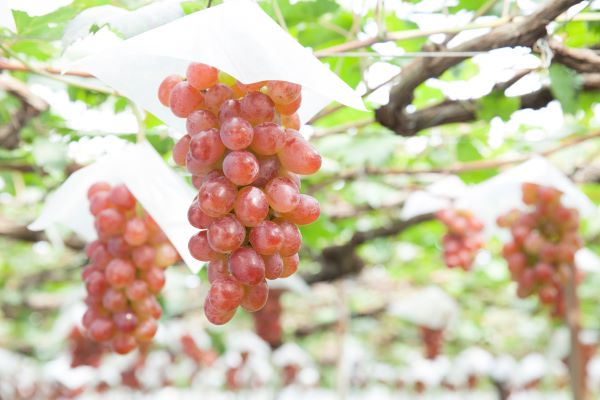
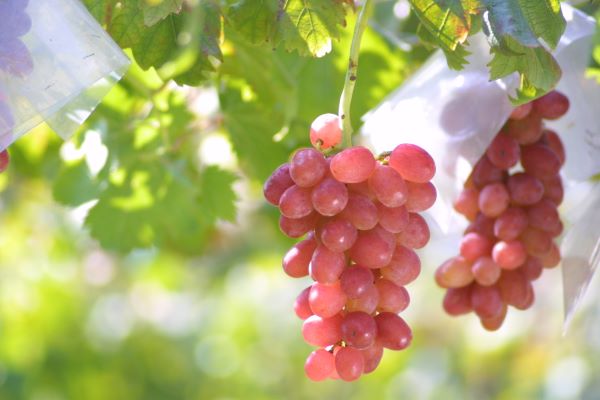
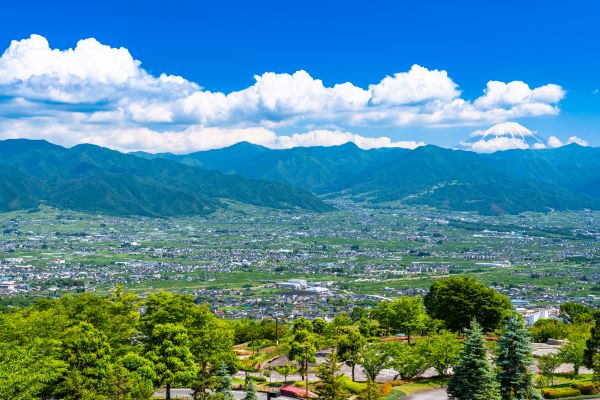
There are still more delicious Yamanashi grapes
We have introduced Shine Muscat and Queen Nina as recommended grapes in Yamanashi Prefecture, but of course, there are still more. Today, we would like to introduce Kyoho, Pione, and Rosario Bianco all at once! As you know, Kyoho has been loved for many years and is also known as the “King of Grapes.” It was named and released in Japan in 1945 and registered as a trademark in 1955. The fruit is purplish-black, and the grain is large, about 10 to 15 g, firm and juicy. It has a good aroma, a strong sweetness and a gentle acidity. Pione is a hybrid of Kyoho grape and Muscat grape. Inheriting the blood of Kyoho grapes, the color is dark purple to purple-black. The grain is slightly larger than Kyoho grapes, and has a refreshing muscat aroma and excellent flavor. It is juicy, has a high sugar content, and has a strong sweetness and acidity to support it. Recently, seedless cultivation is flourishing and it is as popular as Kyoho grapes. Rosario Bianco was developed in Yamanashi Prefecture in 1976. It is a large luxury grape which outdoor cultivation is possible, and is as popular as Shine Muscat. Each grain is about 10 to 13g, and has a high sugar content, a strong sweetness, and a moderate sourness. The aroma is not very strong, but is rich in juice and the texture is juicy. The skin is thin, so you can even eat the skin. Most of the domestic production of the three types of grapes we have introduced is in Yamanashi Prefecture. Please take this opportunity to eat and compare various grapes.
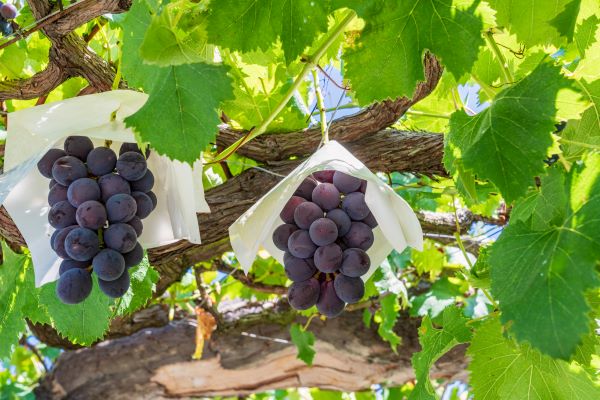
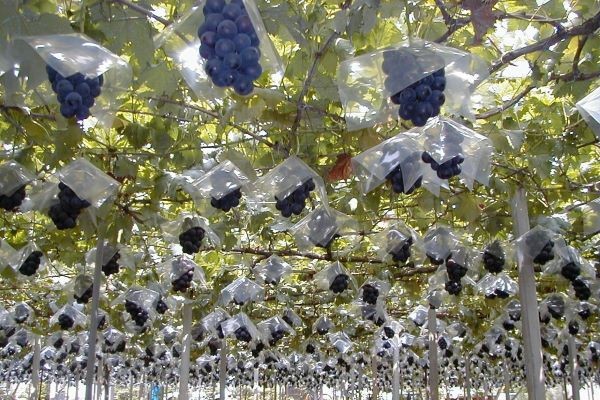
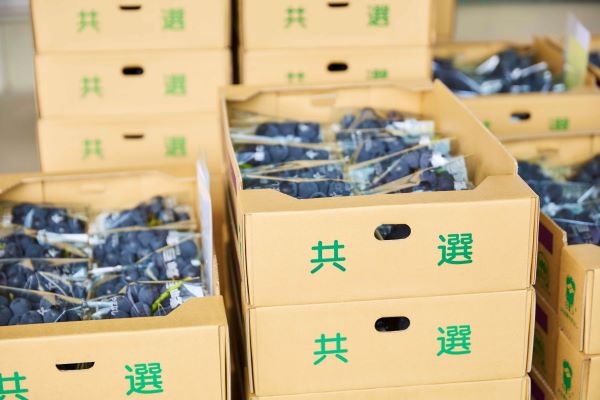
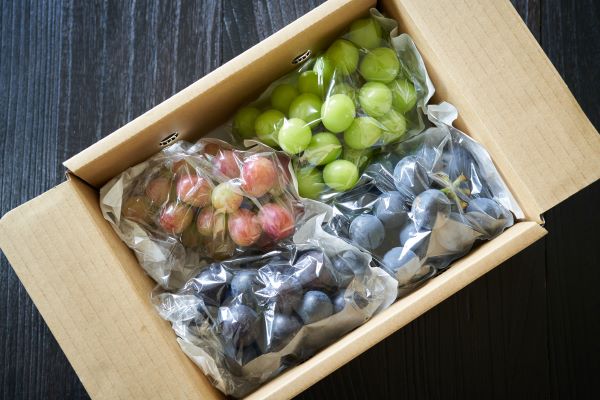
The reason why Yamanashi's agricultural technology never ceases
Last time, we talked about why Yamanashi fruits are so delicious!
It can be said that Yamanashi's strength is that such technology has continued for a long time without dying out.
But it's no coincidence, and here's why:
・Efforts to attract agriculture
Yamanashi Prefecture is known as one of Japan's top producers of fruit. Tech workers tend to lack successors in any industry, and agriculture is no exception.
Yamanashi Prefecture is making various efforts to solve this "shortage of workers".
Attracting people to agriculture is one of those initiatives.
They have organized a consultation team consisting of experts to provide “one-stop support” that can respond to consultations on new farming, management improvement, incorporation,
6th industrialization, corporate entry into agriculture, and retirees farming.
For agricultural equipment rentals, agricultural training, and as a base for agriculture in Kofu City, the "Agricultural Center" provides agricultural training to farmers, promotes agriculture, and provides guidance.
Those who aspire to become farmers, who will lead the next generation, can receive generous support from a wide range of perspectives,
such as the "Agriculture Next-Generation Human Resources Investment Fund," which provides funds to support the establishment of management immediately after starting farming.
As is well known, Yamanashi Prefecture is blessed with a high standard of natural conditions, such as the longest hours of sunshine in Japan,
abundant nature, the temperature difference between day and night due to its high altitude, and mineral-rich water.
However, in growing fruit, there is always the issue of human resources.
Yamanashi Prefecture's plan to attract agriculture will be one of the correct answers when looking ahead 10 to 100 years from now.
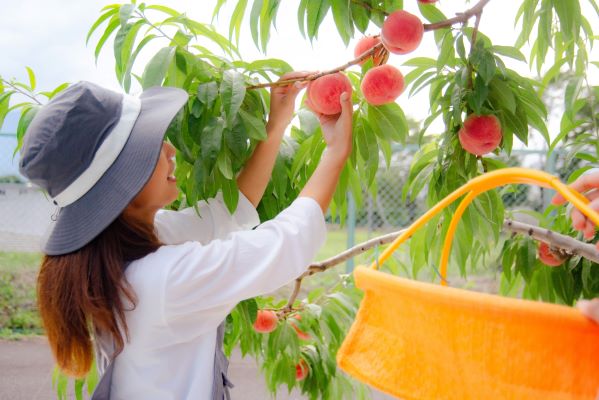
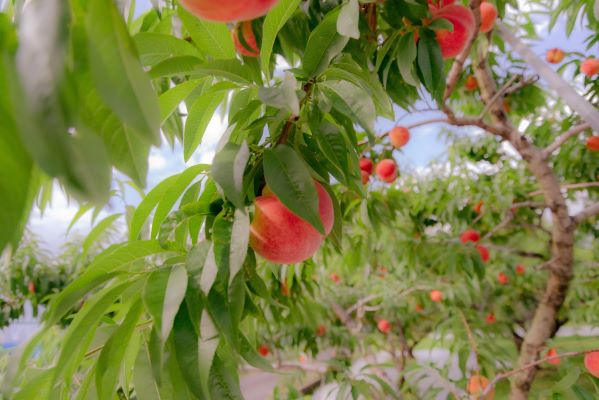
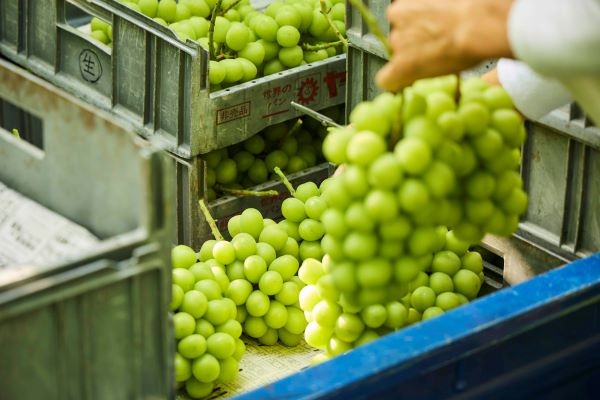
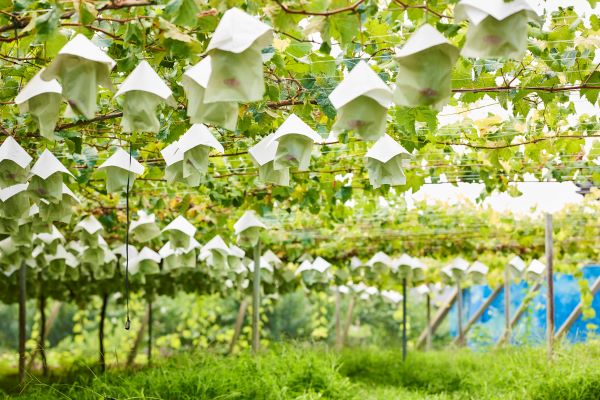
The secret to the deliciousness of Yamanashi fruits
Yamanashi's fruits, regardless of their variety, boast the top level of deliciousness in Japan.
Among them, Shine Muscat is especially delicious! And there is a solid reason for it.
Let’s explore the secret behind the deliciousness of Yamanashi fruits!
1) JA's commitment to fruit sorting
Harvested fruits are sorted into several grades according to whether they are damaged by pests or diseases, and their appearance such as color, luster, and shape, and then they are further sorted by size and weight. This is called fruit sorting.
In Japan, fruits are sorted every day according to the standards set by an agricultural cooperative called Japan Agricultural Cooperatives, JA.
JA is also located in Yamanashi, and is widely known under the name of JA Fruits Yamanashi.
In recent years, non-destructive internal inspection using optical sensors has become mainstream for fruit sorting, and of course, Yamanashi is also adopting this.
The finest fruits carefully cultivated by hand are sorted with the help of machines, and only a handful of the finest fruits are delivered to everyone.
2) History of breed improvement
There are various varieties of grapes around the world, but Shine Muscat is a variety that was born in Japan.
After the Meiji period (1868-1912), various varieties of grapes began to be imported to Japan.
At that time, Japan was simply importing new varieties that had been improved in Europe and the United States.
This is because the new variety suitable for the dry climate of Europe was difficult to cultivate in Japan's rainy climate and soil.
Therefore, by repeatedly crossing American varieties suitable for cultivation in Japan, "Grape Akitsu No. 23", which is the origin of Shine Muscat,
was born by the National Agriculture and Food Research Organization, under the jurisdiction of the Ministry of Agriculture, Forestry and Fisheries, Japan.
This happened in Hiroshima Prefecture in 1988.
After repeated tests and inspections, “Shine Muscat” was registered in 2006.
Today, Shine Muscat can be found in supermarkets and greengrocers, but it actually has such a long history.
Please try Shine Muscat, the fruit of Japan's hard work.
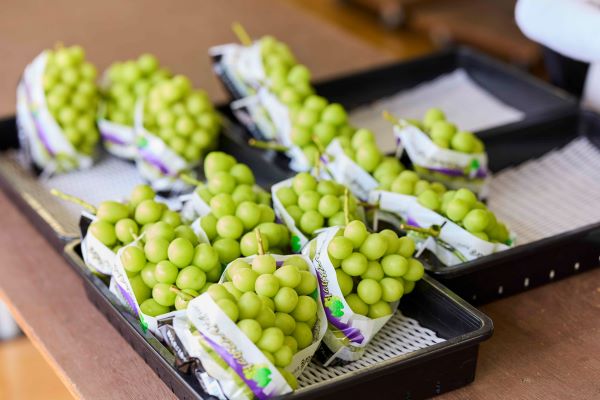
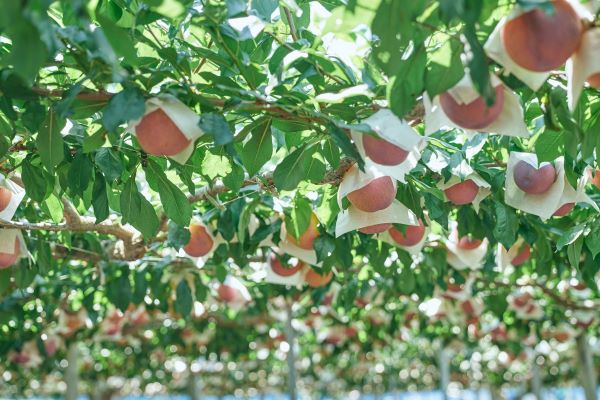
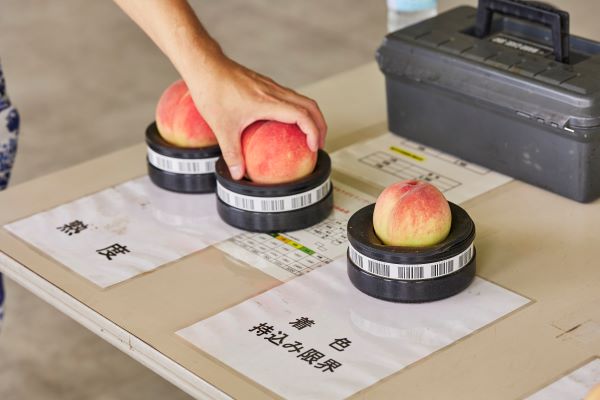
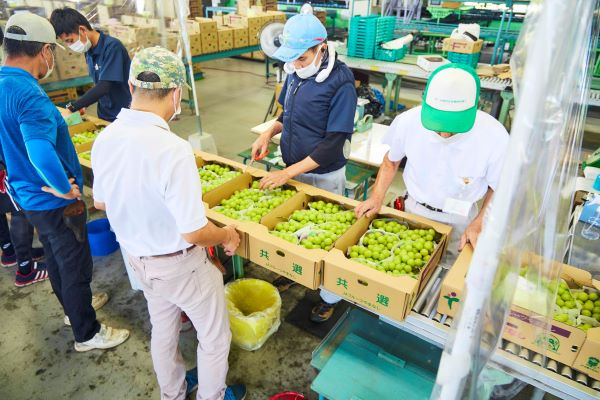
Shine Muscat
・Commitment to quality
・How to eat deliciously
Shine muscats are large and can be eaten whole with the skin, and are very delicious. Today, we will specially introduce a way to eat them more deliciously.
Shine muscat is delicious at room temperature, but we recommend chilling it to enjoy the unique texture.
The point here is to chill it in the refrigerator for 2-3 hours before serving. Grapes are very delicate, so it is not good to cool them too much!
Chill in the refrigerator for 2-3 hours, then gently wash the surface with cold water before serving.
If the bloom runs off, it will lose its freshness easily, so be sure to wash them right before you serve them!
We have already introduced three characteristics of the land why the fruits of Yamanashi Prefecture are said to be delicious:
The temperature difference between day and night is large, the hours of sunshine are long, and the amount of rainfall is low.
Farmers in Yamanashi Prefecture pursue the quality of Shine Muscat every day with even more meticulous quality control.
For example, by completely in-house production and in-house shipping, they can provide grapes picked fresh that morning.
By intentionally reducing the number of clusters per tree, the grapes are made darker and sweeter.
By managing the number of clusters, branches, and leaves, and analyzing the taste, they can stably produce high-quality grapes.
The insatiable curiosity of each and every person involved accumulates and continues to update higher quality.
The taste of the fruit kingdom, Yamanashi Prefecture, cannot be easily imitated. Please check it out for yourself.
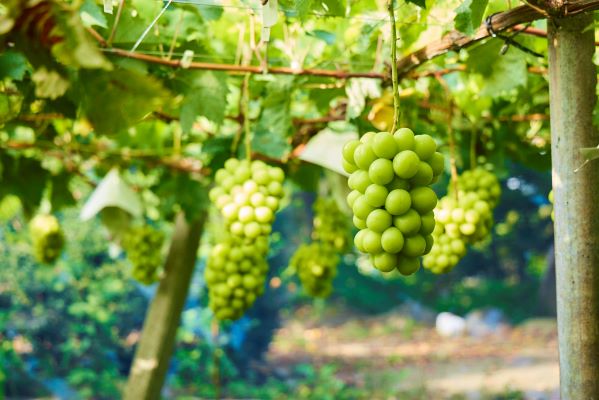
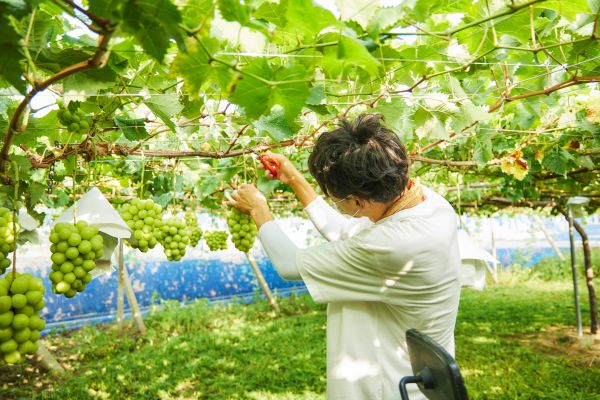
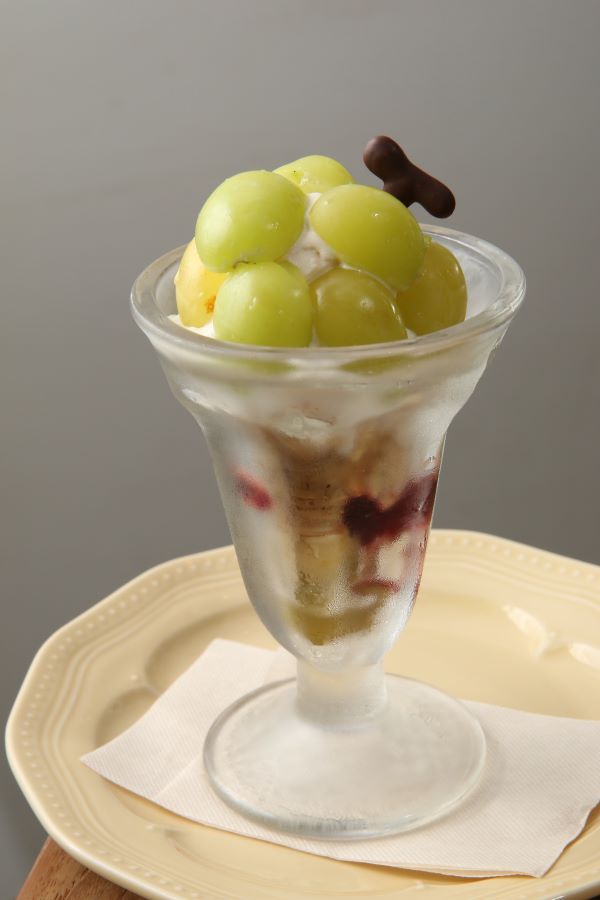
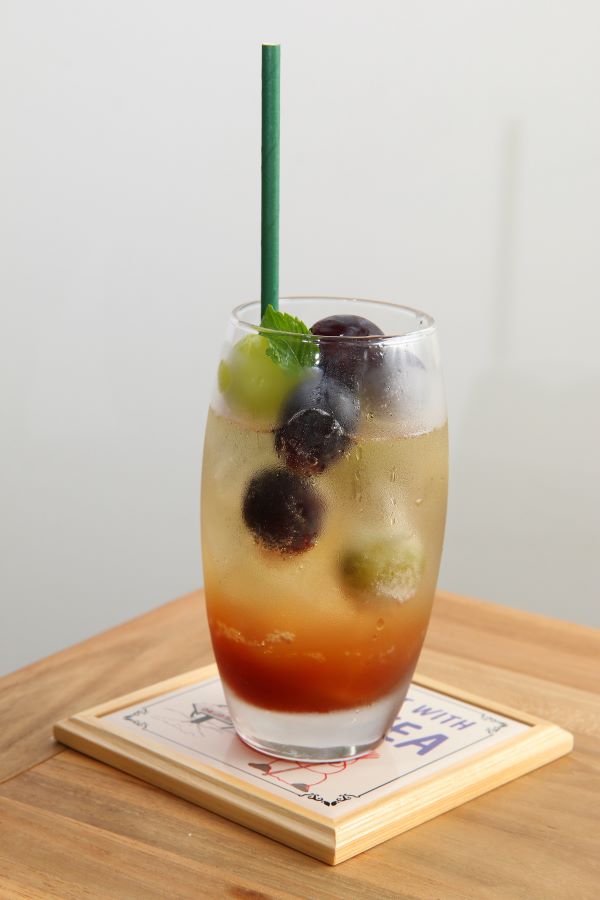
Isawa Onsen
Isawa Onsen in Yamanashi Prefecture, is easy to reach from Tokyo. You can enjoy the hot springs that will warm your body and soul, and the local cuisine of Yamanashi. At JR Isawa Onsen Station, the gateway to Isawa Onsen, you can enjoy a footbath. This is a great service for travelers! It is also recommended for a short break before or after sightseeing. Isawa Onsen is known as one of the leading hot spring towns in eastern Japan. There are over 120 lodging facilities, large and small. Wineries are dotted around Isawa Onsen. Most of them offer free wine and juice tastings and tours. During the tourist season, it is really popular with the visitors. Why not take a trip to Yamanashi, warm your body to the core, and heal your daily fatigue?!Photos provided by: Yamanashi Tourism Organization
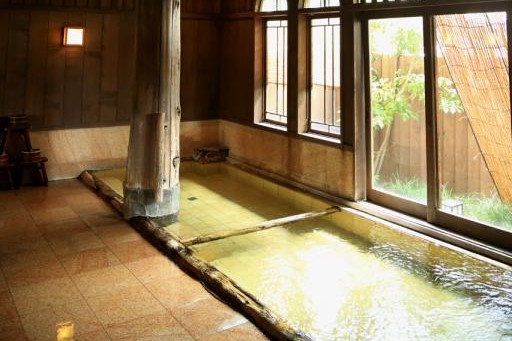
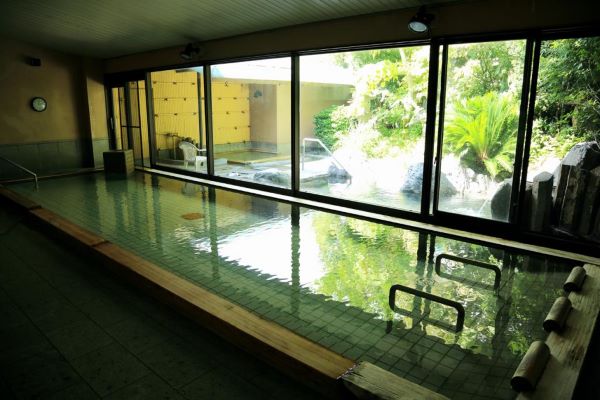
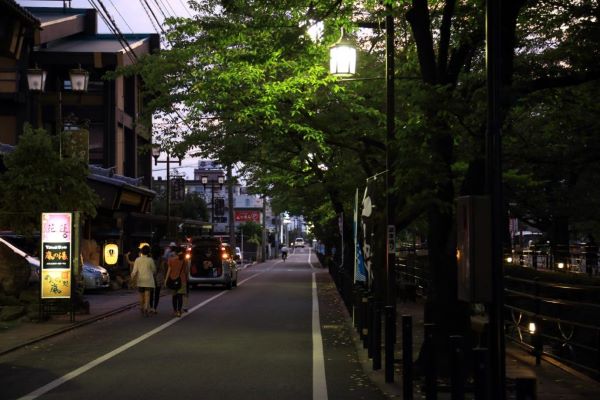
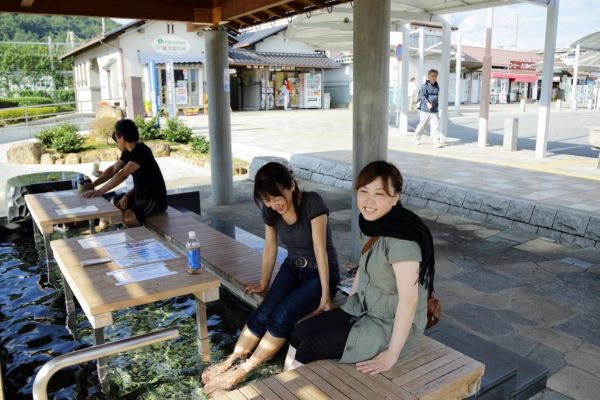
Queen Nina
Do you know the beautiful bright red grape“Queen Nina”? The grapes are large and the sugar content is high, the pulp is hard and has a texture similar to Shine Muscat. It has a rich scent, and if you keep it in the room, the whole room will be wrapped in a sweet scent. You can't eat the skin, but it's seedless, so it's very easy to eat. Koshu City is where grape cultivation is most thriving in Yamanashi Prefecture, which produces the most grapes in Japan. Having the longest daylight hours in Japan and the rich nature, the grapes grow sweet and delicious. Delicious water and air, soil rich in minerals, and a mellow aroma created by rich nature. You can enjoy the juicy and fresh taste! Queen Nina is a new breed of red grape that was just registered in 2011. It was originally a rare breed, but in recent years, the distribution has increased due to the efforts of farmers and governments. If you happen to see them, please be sure to take a look!
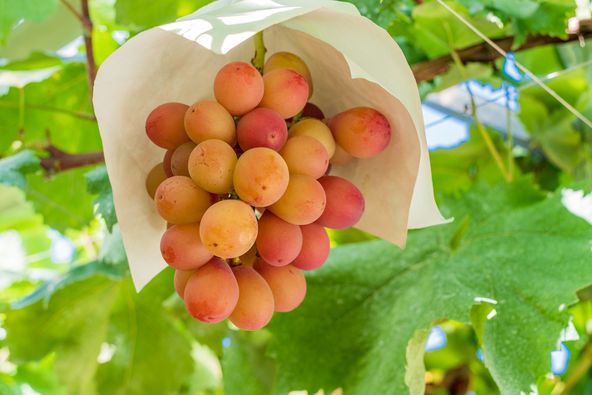
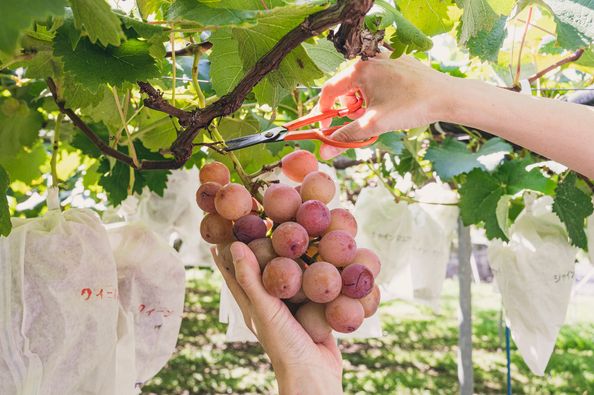
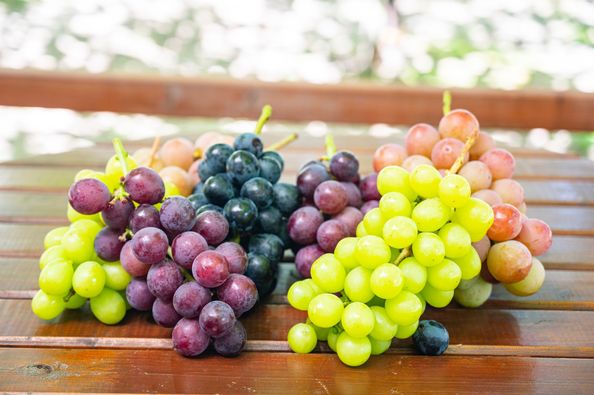
Let's eat delicious seasonal Shine Muscat! What is the proper storage method?
Shine Muscat season is coming soon. Shine Muscat has been particularly popular in Japan in recent years. Sweet and juicy. It's delicious, isn't it?! Today, before shipping Yamanashi Shine Muscat, we will introduce the best way to preserve them so that you can enjoy them for a long time! The best way to preserve Shine Muscat is to refrigerate it. It's a slightly special way of preserving, but please preserve it in this way and enjoy the authentic Yamanashi grapes, which are said to be the best in Japan, to your heart's content. If you refrigerate the whole cluster of Shine Muscat, it will easily lose its freshness due to drying and will deteriorate in about 3 days, so it is best to remove the grains from the cluster before storing. At this time, instead of removing the stem of the grape, cut it leaving a few millimeters from the root. In this way you can preserve without losing quality, and the shelf life can be extended from 5 days to 1 week. They should not be washed with water in order not to remove the natural wax secreted from the surface of the grape fruit called bloom. This is a powder that protects the grapes, and is not a problem! Generally speaking, the more blooms there are, the sweeter and tastier it is. In other words, bloom is proof of freshness. Next time, we will introduce Yamanashi Shine Muscat in a little more detail! Please look forward to it!
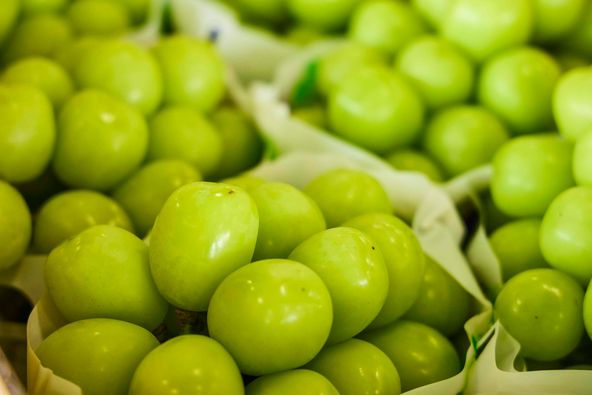
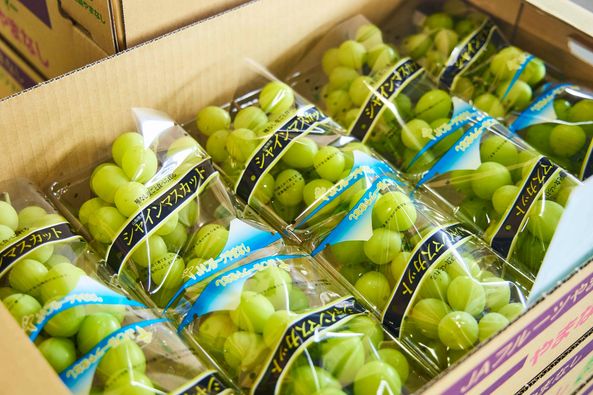
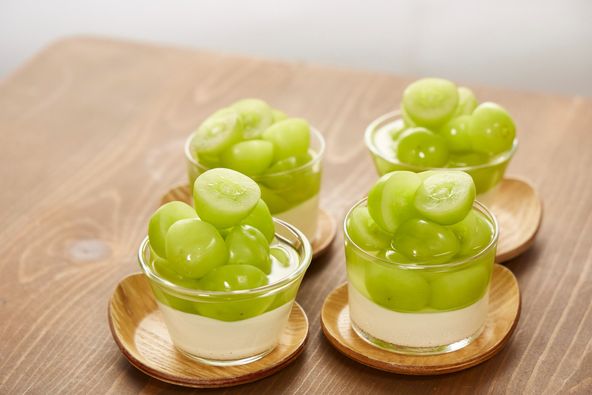
Japan's No. 1? ! The reason why Shine Muscat and Yamanashi fruits are so delicious!
Shine Muscat has been one of the most popular grape varieties in recent years. Yamanashi Prefecture is famous for producing grapes in Japan, and of course Shine Muscat boasts the best quality in Japan. There are various types of grapes, but if you trace the origin, they can be divided into European grapes, that many of which have thin skin and easy to bite, and a muscat flavor, and American grapes with thick skin, that are easy to grow even in the climate of Japan, and hard to bite, and many of which have a foxy flavor. Shine Muscat is a so to speak next-generation hybrid grape made by crossing such European and American grapes. Shine Muscat has a thin skin, so one of its major characteristics is that it can be eaten whole with the skin. The pulp inherits the blood of European grapes, and is easy to chew, has a muscat scent, and has a high sugar content. Cultivation is not as difficult as "Muscat of Alexandria", and the price is affordable, making it a very cost-effective grape. Yamanashi Prefecture is famous for its peaches, but it is also famous for producing grapes, and of course Yamanashi Shine Muscat grapes are also cultivated. The cultivated area is the largest in Japan, and the high level of agricultural technology ensures the quality of the products. The taste of fruits varies greatly depending on the climate and cultivation environment of the land. Shine Muscat is no exception and is a very susceptible grape. As you know, Yamanashi Prefecture, which is also called the fruit kingdom, has the best environment for fruit production, and the reliable technology and know-how that have been cultivated over many years are in harmony at a high level. Please check the taste of Shine Muscat from Yamanashi, the highest peak in Japan, for yourself!
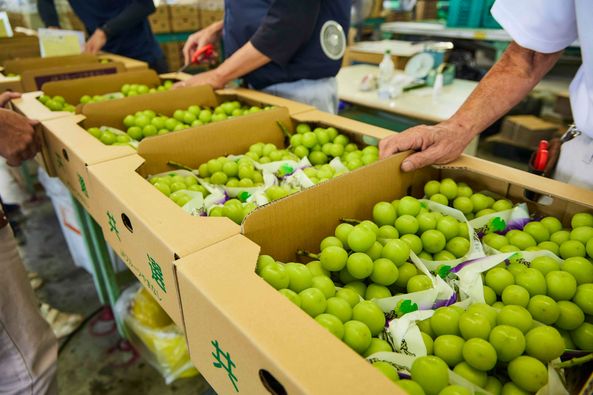

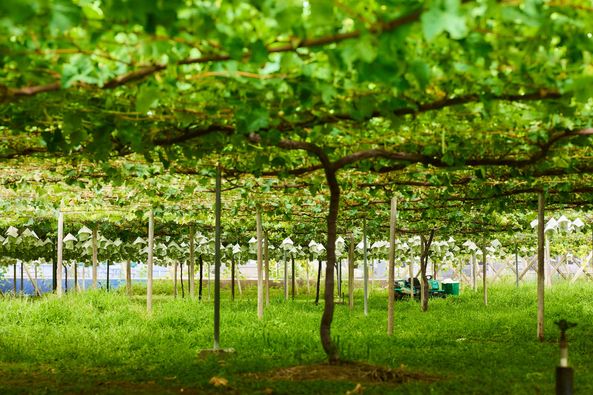
What is unheated honey?
Unheated honey is honey that has not been heated or warmed after honey collection. Most commercially available honey is heat-treated. Inquiries are increasing because there are few honeys labeled as heated or unheated, and consumers cannot judge. All honey is unheated and raw honey if it is bottled straight from the harvest. So why did the word unheated honey come out? Ayurveda probably has something to do with it. Ayurveda is Indian traditional medicine. It is famous for its massage for improving one's physical condition, and there are now many salons specializing in it even in Japan. In fact, it has a wide range of academic systems, not just medicine. When I was listening to an Ayurvedic lecture before, I still remember what the Ayurvedic doctor said. "Honey becomes poisonous when heated." It is speculated that people who study alternative medicine such as Ayurveda and aroma demanded unheated honey, and as a result, it became popular. Nowadays, there is a growing interest in nature and health. Naturally, people who exercise and self-manage their bodies are also very careful about food. Under such circumstances, there is a demand for raw honey that is safe, and has not been heat-treated without adding anything.
